+ データを開く
データを開く
- 基本情報
基本情報
| 登録情報 | データベース: PDB / ID: 1k8d | ||||||
|---|---|---|---|---|---|---|---|
| タイトル | crystal structure of the non-classical MHC class Ib Qa-2 complexed with a self peptide | ||||||
 要素 要素 |
| ||||||
 キーワード キーワード | IMMUNE SYSTEM / non-classical MHC class I / antigen presentation / preimplantation embryo devolepment gene product / Qa-2 / Q9 | ||||||
| 機能・相同性 |  機能・相同性情報 機能・相同性情報: / L13a-mediated translational silencing of Ceruloplasmin expression / SRP-dependent cotranslational protein targeting to membrane / Formation of a pool of free 40S subunits / GTP hydrolysis and joining of the 60S ribosomal subunit / Nonsense Mediated Decay (NMD) independent of the Exon Junction Complex (EJC) / Nonsense Mediated Decay (NMD) enhanced by the Exon Junction Complex (EJC) / Major pathway of rRNA processing in the nucleolus and cytosol / 5.8S rRNA binding / Formation of a pool of free 40S subunits ...: / L13a-mediated translational silencing of Ceruloplasmin expression / SRP-dependent cotranslational protein targeting to membrane / Formation of a pool of free 40S subunits / GTP hydrolysis and joining of the 60S ribosomal subunit / Nonsense Mediated Decay (NMD) independent of the Exon Junction Complex (EJC) / Nonsense Mediated Decay (NMD) enhanced by the Exon Junction Complex (EJC) / Major pathway of rRNA processing in the nucleolus and cytosol / 5.8S rRNA binding / Formation of a pool of free 40S subunits / SRP-dependent cotranslational protein targeting to membrane / Major pathway of rRNA processing in the nucleolus and cytosol / Nonsense Mediated Decay (NMD) independent of the Exon Junction Complex (EJC) / Nonsense Mediated Decay (NMD) enhanced by the Exon Junction Complex (EJC) / L13a-mediated translational silencing of Ceruloplasmin expression / GTP hydrolysis and joining of the 60S ribosomal subunit / Endosomal/Vacuolar pathway / DAP12 interactions / Antigen Presentation: Folding, assembly and peptide loading of class I MHC / ER-Phagosome pathway / DAP12 signaling / Immunoregulatory interactions between a Lymphoid and a non-Lymphoid cell / antigen processing and presentation of peptide antigen via MHC class I / cellular defense response / Neutrophil degranulation / liver regeneration / embryo implantation / lumenal side of endoplasmic reticulum membrane / cellular response to iron(III) ion / negative regulation of forebrain neuron differentiation / antigen processing and presentation of exogenous protein antigen via MHC class Ib, TAP-dependent / iron ion transport / peptide antigen assembly with MHC class I protein complex / regulation of iron ion transport / regulation of erythrocyte differentiation / HFE-transferrin receptor complex / response to molecule of bacterial origin / MHC class I peptide loading complex / T cell mediated cytotoxicity / positive regulation of T cell cytokine production / antigen processing and presentation of endogenous peptide antigen via MHC class I / MHC class I protein complex / positive regulation of receptor-mediated endocytosis / negative regulation of neurogenesis / cellular response to type II interferon / cellular response to nicotine / positive regulation of T cell mediated cytotoxicity / multicellular organismal-level iron ion homeostasis / phagocytic vesicle membrane / negative regulation of epithelial cell proliferation / sensory perception of smell / positive regulation of cellular senescence / T cell differentiation in thymus / negative regulation of neuron projection development / protein refolding / large ribosomal subunit rRNA binding / protein homotetramerization / cytosolic large ribosomal subunit / amyloid fibril formation / intracellular iron ion homeostasis / cytoplasmic translation / learning or memory / structural constituent of ribosome / translation / external side of plasma membrane / synapse / nucleolus / structural molecule activity / Golgi apparatus / protein homodimerization activity / extracellular space / RNA binding / cytoplasm / cytosol 類似検索 - 分子機能 | ||||||
| 生物種 |  | ||||||
| 手法 |  X線回折 / X線回折 /  シンクロトロン / シンクロトロン /  分子置換 / 解像度: 2.3 Å 分子置換 / 解像度: 2.3 Å | ||||||
 データ登録者 データ登録者 | He, X. / Tabaczewski, P. / Ho, J. / Stroynowski, I. / Garcia, K.C. | ||||||
 引用 引用 |  ジャーナル: Structure / 年: 2001 ジャーナル: Structure / 年: 2001タイトル: Promiscuous antigen presentation by the nonclassical MHC Ib Qa-2 is enabled by a shallow, hydrophobic groove and self-stabilized peptide conformation. 著者: He, X. / Tabaczewski, P. / Ho, J. / Stroynowski, I. / Garcia, K.C. | ||||||
| 履歴 |
| ||||||
| Remark 999 | SEQUENCE THE CONFLICT IS BECAUSE THE STRUCTURE IS OF THE Q9 ALLELE OF QA-2, WHICH IS GLU AT THIS ...SEQUENCE THE CONFLICT IS BECAUSE THE STRUCTURE IS OF THE Q9 ALLELE OF QA-2, WHICH IS GLU AT THIS POSITION. THE P14429 REFERENCE IS FOR THE SEQUENCE OF THE Q7 ALLELE OF QA-2, WHICH IS GLN AT THIS POSITION. |
- 構造の表示
構造の表示
| 構造ビューア | 分子:  Molmil Molmil Jmol/JSmol Jmol/JSmol |
|---|
- ダウンロードとリンク
ダウンロードとリンク
- ダウンロード
ダウンロード
| PDBx/mmCIF形式 |  1k8d.cif.gz 1k8d.cif.gz | 96.5 KB | 表示 |  PDBx/mmCIF形式 PDBx/mmCIF形式 |
|---|---|---|---|---|
| PDB形式 |  pdb1k8d.ent.gz pdb1k8d.ent.gz | 73 KB | 表示 |  PDB形式 PDB形式 |
| PDBx/mmJSON形式 |  1k8d.json.gz 1k8d.json.gz | ツリー表示 |  PDBx/mmJSON形式 PDBx/mmJSON形式 | |
| その他 |  その他のダウンロード その他のダウンロード |
-検証レポート
| 文書・要旨 |  1k8d_validation.pdf.gz 1k8d_validation.pdf.gz | 379.5 KB | 表示 |  wwPDB検証レポート wwPDB検証レポート |
|---|---|---|---|---|
| 文書・詳細版 |  1k8d_full_validation.pdf.gz 1k8d_full_validation.pdf.gz | 395.1 KB | 表示 | |
| XML形式データ |  1k8d_validation.xml.gz 1k8d_validation.xml.gz | 11 KB | 表示 | |
| CIF形式データ |  1k8d_validation.cif.gz 1k8d_validation.cif.gz | 17.5 KB | 表示 | |
| アーカイブディレクトリ |  https://data.pdbj.org/pub/pdb/validation_reports/k8/1k8d https://data.pdbj.org/pub/pdb/validation_reports/k8/1k8d ftp://data.pdbj.org/pub/pdb/validation_reports/k8/1k8d ftp://data.pdbj.org/pub/pdb/validation_reports/k8/1k8d | HTTPS FTP |
-関連構造データ
| 関連構造データ | 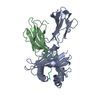 1vacS S: 精密化の開始モデル |
|---|---|
| 類似構造データ |
- リンク
リンク
- 集合体
集合体
| 登録構造単位 | 
| ||||||||
|---|---|---|---|---|---|---|---|---|---|
| 1 |
| ||||||||
| 単位格子 |
|
- 要素
要素
| #1: タンパク質 | 分子量: 31628.252 Da / 分子数: 1 断片: EXTRACELLULAR ALPHA-1, EXTRACELLULAR ALPHA-2, EXTRACELLULAR ALPHA-3 由来タイプ: 組換発現 / 由来: (組換発現)   |
|---|---|
| #2: タンパク質 | 分子量: 11704.359 Da / 分子数: 1 / 由来タイプ: 組換発現 / 由来: (組換発現)   |
| #3: タンパク質・ペプチド | 分子量: 1136.429 Da / 分子数: 1 / 断片: residues 137-145 / 由来タイプ: 合成 詳細: The peptide was chemically synthesized. The sequence of the peptide is naturally found in Mus musculus (mouse). 参照: UniProt: P14118, UniProt: P84099*PLUS |
| #4: 水 | ChemComp-HOH / |
| Has protein modification | Y |
-実験情報
-実験
| 実験 | 手法:  X線回折 / 使用した結晶の数: 1 X線回折 / 使用した結晶の数: 1 |
|---|
- 試料調製
試料調製
| 結晶 | マシュー密度: 2.04 Å3/Da / 溶媒含有率: 39.74 % | ||||||||||||||||||||||||||||||||||||||||||
|---|---|---|---|---|---|---|---|---|---|---|---|---|---|---|---|---|---|---|---|---|---|---|---|---|---|---|---|---|---|---|---|---|---|---|---|---|---|---|---|---|---|---|---|
| 結晶化 | 温度: 295 K / 手法: 蒸気拡散法, シッティングドロップ法 / pH: 7.2 詳細: PEG6000, HEPES, sodium chloride, pH 7.2, VAPOR DIFFUSION, SITTING DROP, temperature 295K | ||||||||||||||||||||||||||||||||||||||||||
| 結晶化 | *PLUS | ||||||||||||||||||||||||||||||||||||||||||
| 溶液の組成 | *PLUS
|
-データ収集
| 回折 | 平均測定温度: 100 K |
|---|---|
| 放射光源 | 由来:  シンクロトロン / サイト: シンクロトロン / サイト:  SSRL SSRL  / ビームライン: BL9-2 / 波長: 1.08 Å / ビームライン: BL9-2 / 波長: 1.08 Å |
| 検出器 | タイプ: ADSC QUANTUM 4 / 検出器: CCD / 日付: 2000年1月1日 |
| 放射 | プロトコル: SINGLE WAVELENGTH / 単色(M)・ラウエ(L): M / 散乱光タイプ: x-ray |
| 放射波長 | 波長: 1.08 Å / 相対比: 1 |
| 反射 | 解像度: 2.3→50 Å / Num. all: 16467 / Num. obs: 16467 / % possible obs: 97.6 % / Observed criterion σ(F): 0 / Observed criterion σ(I): 0 / Rmerge(I) obs: 0.112 |
| 反射 シェル | 解像度: 2.3→2.38 Å / Rmerge(I) obs: 0.37 / % possible all: 99 |
| 反射 | *PLUS 最低解像度: 60 Å / Num. measured all: 61755 |
| 反射 シェル | *PLUS 最高解像度: 2.3 Å / % possible obs: 99 % / Rmerge(I) obs: 0.37 |
- 解析
解析
| ソフトウェア |
| |||||||||||||||||||||||||
|---|---|---|---|---|---|---|---|---|---|---|---|---|---|---|---|---|---|---|---|---|---|---|---|---|---|---|
| 精密化 | 構造決定の手法:  分子置換 分子置換開始モデル: PDB ENTRY 1VAC 解像度: 2.3→50 Å / Isotropic thermal model: Isotropic / 交差検証法: THROUGHOUT / σ(F): 0 / σ(I): 0 / 立体化学のターゲット値: Engh & Huber
| |||||||||||||||||||||||||
| 原子変位パラメータ | Biso mean: 30.2 Å2
| |||||||||||||||||||||||||
| Refine analyze |
| |||||||||||||||||||||||||
| 精密化ステップ | サイクル: LAST / 解像度: 2.3→50 Å
| |||||||||||||||||||||||||
| 拘束条件 |
| |||||||||||||||||||||||||
| LS精密化 シェル | 解像度: 2.3→2.38 Å / Rfactor Rfree error: 0.043
| |||||||||||||||||||||||||
| ソフトウェア | *PLUS 名称: CNS / 分類: refinement | |||||||||||||||||||||||||
| 精密化 | *PLUS 最低解像度: 60 Å / σ(F): 0 / % reflection Rfree: 5 % | |||||||||||||||||||||||||
| 溶媒の処理 | *PLUS | |||||||||||||||||||||||||
| 原子変位パラメータ | *PLUS Biso mean: 30.2 Å2 | |||||||||||||||||||||||||
| 拘束条件 | *PLUS
| |||||||||||||||||||||||||
| LS精密化 シェル | *PLUS Rfactor Rfree: 0.365 / Rfactor Rwork: 0.285 / Rfactor obs: 0.285 |
 ムービー
ムービー コントローラー
コントローラー



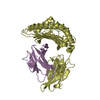


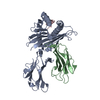
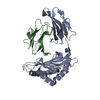
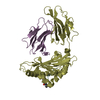
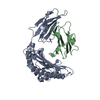



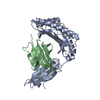

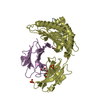


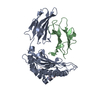
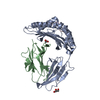
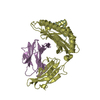
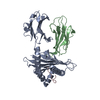

 PDBj
PDBj














